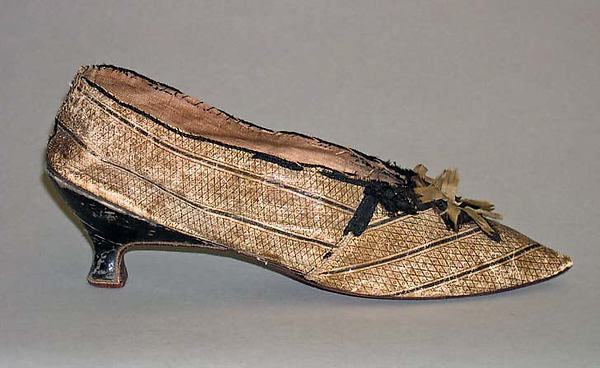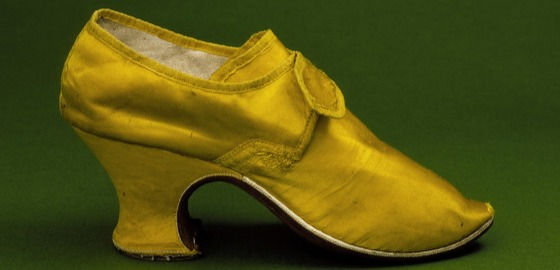18th Century Footwear
- Rani Jain
- Dec 1, 2018
- 3 min read
Updated: Jun 20, 2021
The display of wealth through fashionable clothes was also seen on the feet in the eighteenth century. Both men and women of wealth wore fancy shoes that signaled their status, a trend that died out by the end of the century.

Women wore high-heeled shoes made of colorful silk or delicate leather, sometimes decorated with gold and silver lace and braid. Although women wore heavily decorated silk dresses, their shoes were rarely made from matching material; to do so would be much too expensive. Some shoes were laced, but most had decorative buckles. The toes of women's shoes were pointed or slightly rounded. These elaborate women's shoes were replaced at the end of the century, however, with much simpler styles, including the especially popular slipper.
Three different heel types developed in Europe during the eighteenth century.
o The Italian Heel was tall and spiked, like a stiletto.
The Italian heel was common for the 1780s and 90s, and featured a slender waist and small flare at the base. A large wedge supported the arch. The term "Italian heel" hasn't been in use since the 18th century, but has been replaced by "Kitten heel," a small, low heel with a sharp taper and sometimes a small flare at the base.


o The French Heel
Also called the "Louis" heel, after King Louis XIV, the French heel, was of mid-height, features a curved "waist," with a flare at the bottom. The front side of the heel (the "breast"), under the arch of the foot, has an inward curve, and the sole covers the breast, the arch, and down under the ball of the foot, in one piece.


o The English Heel was thicker and generally low to mid-height. Fashionable continental European women were more inclined to be at court or at home in an urban setting, so their heels could generally be more delicate, while English women of breeding tended to live at their country estates for most of the year, so a thicker heel was necessary for the more natural terrain they traversed.

When the skirts of French gowns inched toward the ankles in the mid-eighteenth century, suddenly there seemed to be an erotic interest in the high-heeled shoe, as it made the foot appear smaller and narrower, and gave the ankle a delicate shape. A lady of quality, however, did not walk the streets and likely traveled by coach or other means, so a high heel was appropriate for most occasions she would encounter.
· Buckle
Both men and women increasingly suffered from buckle mania throughout the eighteenth century. Buckles grew in size and became more elaborate, set with showy paste and semiprecious stones. Men's buckles were larger but both sexes displayed their shoe jewelry during a bow and curtsy with extended foot-the appropriate method of introduction of the day.

In the early months of the French Revolution, the French National Assembly demanded that all deputies give up their valuable shoe buckles for the benefit of the treasury. The legislative session of 22 November 1789 opened with le Marechal de Maille making the patriotic gift of his gold buckles.
· Slippers
After the French Revolution (1789–99), people began to reject obvious signs of wealth. The large buckles and elaborate patterned silk shoes of earlier days were replaced with simple, plain flat-soled slippers. Slippers were made of thin kid, the skin of a baby goat, or cloth. The toes of slippers were either pointed or rounded, and the throat of the shoe, or the opening at the top of the foot, was cut into a U or V shape. The throat was left plain or a small bow was added. Slippers were often dyed to match a woman's pelisse (a light-weight coat), sash, or gloves. Light colors of green, pink, and purple were popular. Slippers first became popular for women, but by the nineteenth century men wore black slippers to formal events as well.

late 18th century, French, women’s slipper, Silk, silk brocade, silk and metal thread embroidery, silk ribbon, and leather and linen lining



Comments